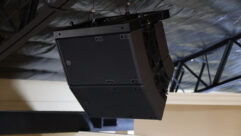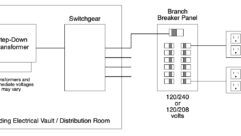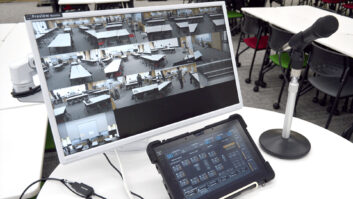Little PROBLEMS
Aug 1, 1998 12:00 PM,
Ted Uzzle
Acoustical theory begins in a universe that doesn’t exist. It’s a universeof sound sources infinitesimally small, which radiate equally in alldirections. The sound radiation takes place in a completely homogeneousmedium that extends infinitely in all directions without hindrance.
Here on the messy planet earth, things are more complicated. Reverberationtheory was developed in the early 1890s by Wallace Clement Sabine(1868-1919). It was not until the late 1970s and early 1980s thatreverberation was shown to have been all along a branch of statisticalmechanics, which had been developed in the 1870s by Willard Gibbs(1839-1903).
Large-room acousticsReverberation theory has two parts. One part, developed by Sabine,describes the behavior of reverberant sound over time. The other, developedin the 1940s by H. F. Hopkins and N. R. Stryker, describes the behavior ofreverberant sound in space. Reverberant sound may be visualized in thisway. Imagine a fine mesh kitchen strainer, and poured into the center of itis some such heavy, syrupy fluid as molasses. Pour fast enough, and thelevel of the molasses rises in the strainer, maintaining a flat top surfaceexcept at the point where the molasses is being poured in. At this point,the level rises to meet the in-flowing stream. Stop pouring, and themolasses will eventually flow out completely.
Unless you want a nasty clean-up job, leave the strainer and the molassesas a thought experiment. Learn what the analogy has to teach, however. Thefluid flows in at one rate, determined by the source (how far you tilt thebottle and how wide is its mouth), and flows out at another ratealtogether, determined by the density of the fluid and the fineness of thestrainer mesh and independent of the rate at which you had poured in.
Reverberant sound is sound that has flowed into a room, perhaps from aloudspeaker, and then been reflected around the room repeatedly, until itachieves three conditions. It is equal in level at all points in the room;at any point it has equal probability of arriving from any direction; ithas a completely random phase relationship with itself or with the directsound arriving at that point. There, in summary, is the formal definitionof reverberant sound.
When the sound source is shut off, the sound decays at a rate fixed by thecubic volume of the room, and the ability of the room boundaries,furnishings and occupants to absorb sound, which means to convert soundenergy to heat. The time required for reverberant sound to decay 60 dB is T= 0.049 V / A where T is time in seconds, V is the room’s volume inft[superscript]3, A is total absorption in customary sabins, and 0.049 is aunit correction coefficient. In metric units, T = 0.161 V / A where V isroom volume in m[superscript]3, A is total absorption in metric sabins, and0.161 is a unit correction coefficient.
While a point source of sound operates, sound emanating directly from itradiates with a sound-pressure level that decreases at 6 dB per doubling ofdistance. Reverberant sound, however, has the same pressure level at alldistances, and at all points in the room. At some distance from the source,the direct sound and the reverberant sound are at equal levels. Becausethey bear only a random phase relationship to each other, the soundpressure level at this distance is 3 dB greater than that of thereverberant and direct sounds. Beyond that distance, the sound-pressurelevel approaches that of the reverberant sound only. (See Figure 1.)
All this works spot-on for quite large rooms, those with reverberationtimes of about 1.25 s or longer. In rooms with reverberation times ofaround one second, it gets quite iffy, and in much smaller rooms, withreverberation times well below one second, it breaks down completely.
Why should that be so? Primarily it has to do with room size. If a room ismade smaller, the shape kept the same and all dimensions remaining inproportion, the room’s volume diminishes faster than the room’s surfacearea. The room’s surface area changes with the square root of the linearreduction, while the room’s volume changes with the cube root of the linearreduction.
This means that even though the room remains the same shape, the ratio ofvolume to surface is reduced. As a consequence, the distance each sound raytravels between each reflection from room surfaces is reduced. In a givenelapsed time, there are more opportunities for the room surface to convertthe sound energy to heat. As rooms get very small, the furnishings in theroom (such as chairs and people) become a bigger share of the room’s totalabsorption, and wall absorption becomes less important.
Another effect has to do with the lengths of sound waves. Light waves areso much smaller than the dimensions or furnishings of human-sized rooms,and so much smaller than people, that room geometry and human-body geometryhave no effect. It’s very different with audible sound. The lowestfrequencies we can hear are about as long as the height of a four-storyhouse. They are about twice the length of the largest domestic roomdimensions. The highest frequencies we can hear have wavelengths a bitshorter than the diameter of the human outer ear. As a consequence, realrooms in houses, and our own bodies, have major effects on thetransmission, reflection, refraction and diffraction of audible soundsaround us.
Frequency-dependent analysisIn small rooms, we need to divide the audible spectrum into four bands andapply a different analytical technique to the study of the acoustics ofeach.
Let L be the longest dimension in a room. Sound behavior in the roomchanges above and below the frequency 565 / L if L is in feet or 172 / L ifL is in meters. The frequency calculated this way is the lowest frequencythat can have one complete wavelength inside the room. By superposition onitself, it can create a standing wave, and points of reinforcement and nullin the room. Above this frequency, the room’s acoustics are dominated bynormal modes, by interactions between the wavelengths and the roomdimensions. Below this frequency, it is extremely difficult to develop anyappreciable sound energy in the room, and the room offers little or nobeneficial assistance to the sound source.
The normal modes of a room may be defined as those frequencies whosewavelengths correspond to room dimensions. The dimensions may be axial,tangential or oblique. Additional normal modes are integer multiples of thefrequencies defined this way. As we shall see, normal modes are usually badnews indeed for the listening quality of a room.
Consider a room whose longest dimension is 18 ft (5.5 m). Above about565/18 Hz, or 31 Hz, room acoustics are dominated by normal modes andstanding waves. Below about 31 Hz, the room’s acoustics are dominated bythe pressure output of the sound source.
Let’s think for a moment about those normal modes, and the standing wavesthey can create. The frequency of the normal mode in a room is:
Consult Printed Publication for Formula
where c is the speed of sound, x, y and z are the room’s three-dimensionalframe of reference, lx, ly and lz are the lengths of room dimensions in x,y and z axes, and nx, ny, and nz are room modal numbers. The room mode 1,0, 0 is the axial mode controlled by lx, the length of the room in the xdirection. If the length of the in the direction is 22 ft (6.7 m), themodal frequency is:
Consult Printed Publication for Formula
which is about 26 Hz. Figure 2 shows the theoretical distribution of soundin this room.
Consider the tangential mode 1, 1, 0. Here, the source of the sound isplaced in a corner of the room. The wave propagates with the x-dimensionwall on one side and the y-dimension wall on the other. The wave isparallel to the z-axis, which has no effect on it. If the x and ydimensions are 22 ft (6.7 m) and 14 ft (4.3 m), then the frequency of thisbehavior is:
Consult Printed Publication for Formula
which is about 48 Hz. Figure 3 shows the theoretical distribution of soundin this room.
How can we describe the acoustics of rooms in the frequency area wherenormal modes predominate? Here the room behaves as a high-Q band-passfilter (“Q” refers to the quality factor of a filter, the ratio ofreactance to resistance in a circuit). As would be true of such anelectrical circuit, the room stores energy when activated acoustically andthen releases it later. The storage-and-release takes place at thenormal-mode frequencies only, giving the sound certain frequencies at whichit responds disproportionally. The sound also varies dramatically accordingto the listening position in the room.
Each of these modes has a different rate of decay. The rate of decay isdetermined by the absorption on facing, opposite walls in the case of axialmodes, by the absorption on two adjacent walls in the case of tangentialmodes, and by the absorption on three adjacent walls in the case of obliquemodes. When we view decay as a function of frequency, we can see somenarrow frequency bands decay dramatically more slowly than others. Also,the decay in some bands can have multiple rates, as shown in Figure 4.
We are justified in saying sound behaves quite badly in the frequency areaswhere normal modes predominate. Such rooms can have interesting properties.When we sing in the shower, or a busker sings in a subway station, or anews vendor calls out headlines in a train station, the voice finds thosefrequencies which reinforce the sound and exploits them. When we wantnatural reproduction of voice, music or sound effects, these rooms areannoying.
How to correct the problem of normal modes in rooms? The best solutions arearchitectural. Move the walls so the ordinate dimensions of the room do notreinforce the same modes. There has been much research in the area ofpreferred room dimensions, and there are certain ratios of length, widthand height that minimize these problems. Another solution is to tilt wallsto break up their parallelism. This widens the room-mode bandpasses so theywill have less reactive effect.
Probably the least useful solution is absorption. Drape the parallel,facing walls that create the worst modes, we are told. Unfortunately, theabsorption of a wall treatment is frequency dependent, and low-frequencyabsorbers are complicated and expensive structures.
The most practical solution is to move the loudspeakers. This cannot makethe problem go away, but can mitigate it somewhat. Besides, it’s cheap andwithin the control of the system designers and installers.
Diffusion and reflectionJust as there is a frequency below which normal modes do not dominate theroom’s acoustics, there is a frequency above which normal modes do notdominate, either. This frequency is given by:
Consult Printed Publication for Formula
where T is the reverberation time in seconds and V is the room volume inft[superscript]3. In the metric system, there is a differentunit-correction constant, and the formula looks like this:
Consult Printed Publication for Formula
where V is the room cubic volume in m[superscript]3.
Above this new frequency, sound distribution is controlled by diffusion anddiffraction in the room. We have now entered a frequency band in whichdeeply sculpted wall treatments have a major effect. Coffers in theceiling, polycylinders on the walls and a newer class of acousticalproduct, quadratic-residue diffusors, all contribute heavily to soundquality. If the room is sufficiently small, such a domestic living room ora home cinema, chairs and audience will contribute heavily to sounddiffusion, but only in this frequency area.
Sound will be diffracted and diffused by objects sized approximately fourtimes the wavelength of the sound. Much smaller than this, and they becomeinvisible to sound waves; much larger than this, and they become simplereflectors, like the walls. Once you identify the frequency region in whichdiffusion is the predominate acoustical activity, you must size yourdiffusors to the appropriate wavelengths.
The diffusion effect works in a frequency band only two octaves wide. Abovethe frequency:
Consult Printed Publication for Formula
or, in metric units:
Consult Printed Publication for Formula
the wavelengths are so small compared to room dimensions that the acousticsare controlled by reflection and absorption at room boundaries. In thisfrequency band we come closest to classical big-room acoustic techniques,although they will probably not work perfectly even here. We control soundin this frequency area with absorption. Ironically, the traditional meansof treating small rooms (carpet or absorptive foam on the walls) will havean effect only above the frequency defined above, with almost none below.
This four-frequency-band analysis may be applied to all rooms. In largerooms, public-assembly places, the lowest three bands are all so low infrequency we can disregard them, and apply classical Sabinian techniques.As the room gets smaller, the three lower bands move up in frequency, andin the smallest rooms occupy most of the audible spectrum. That’s why inthe smallest rooms we need many different types of analysis and differenttechniques to understand the behavior of sound. We should heed an aptwarning: “Application of a good technique at the incorrect frequency is asdisastrous as choosing the wrong technique.” (Davis and Davis, 1987, p. 209)
1. Leo L. Beranek, Acoustics, American Institute of Physics, 1986.
2. Don Davis and Carolyn Davis, “The special LEDE TM workshop,” Syn-Aud-ConTech Topic v. 9 n. 5, spring 1982.
3. Don Davis and Carolyn Davis, Sound System Engineering, second edition,Howard W. Sams, 1987. This book is now published by Focal Press.
4. F. Alton Everest, “Acoustics of small rooms,” in Glen Ballou, Ed.,Handbook for Sound Engineers, The New Audio Cyclopedia, second edition,Howard W. Sams, 1991, pp. 43-66. This book is now published by Focal Press.










